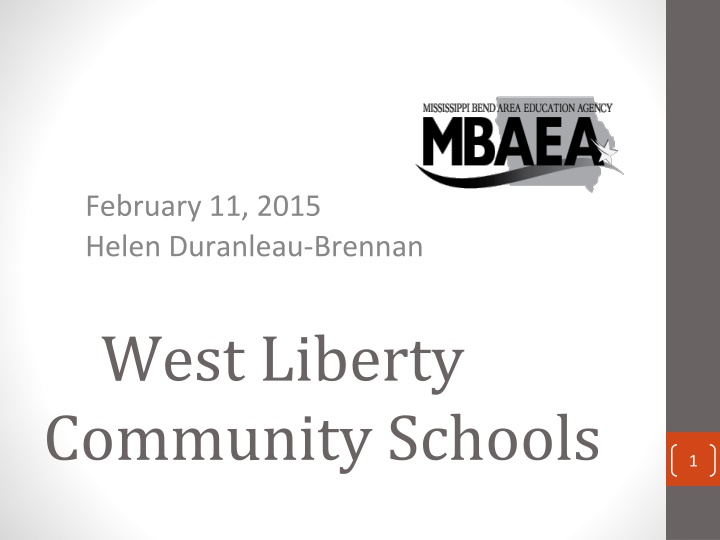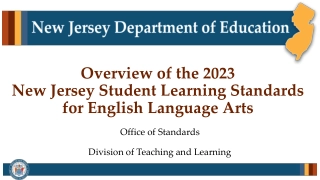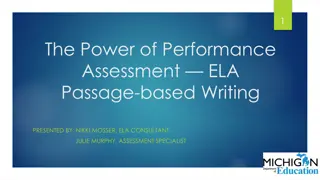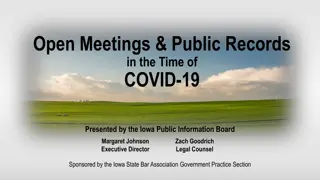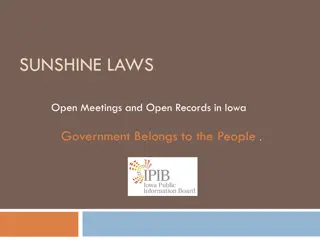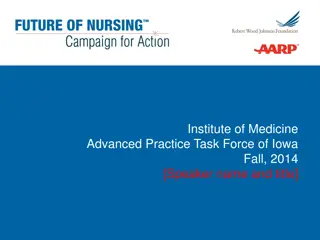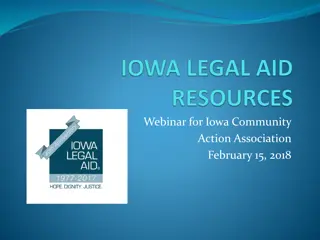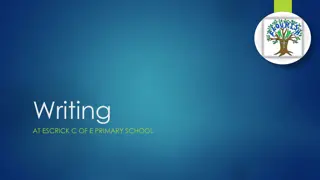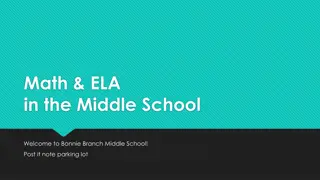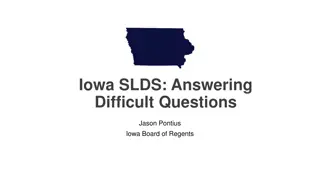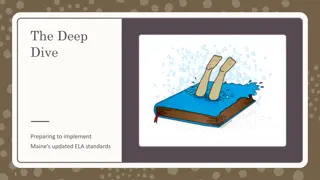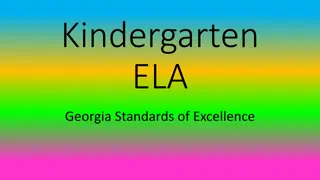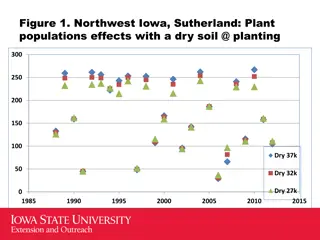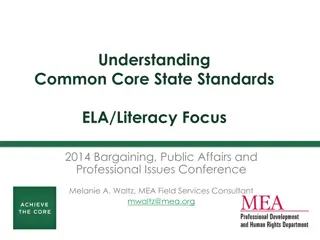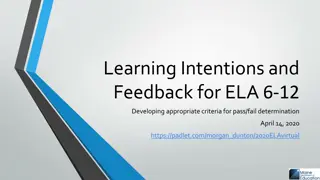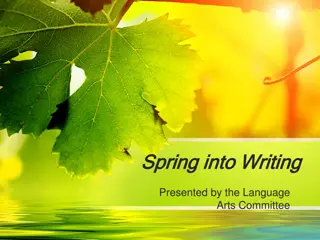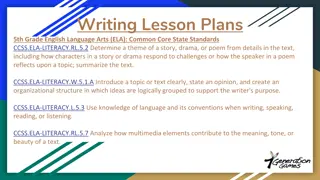Enhancing Writing Skills through Iowa Core ELA Standards
Explore the session goals, learning targets, professional considerations, and literacy standards aimed at improving writing skills based on the Iowa Core ELA Standards. Discover the importance of argumentation writing, incorporating standards effectively, and fostering creativity through informative/explanatory tasks.
Download Presentation

Please find below an Image/Link to download the presentation.
The content on the website is provided AS IS for your information and personal use only. It may not be sold, licensed, or shared on other websites without obtaining consent from the author.If you encounter any issues during the download, it is possible that the publisher has removed the file from their server.
You are allowed to download the files provided on this website for personal or commercial use, subject to the condition that they are used lawfully. All files are the property of their respective owners.
The content on the website is provided AS IS for your information and personal use only. It may not be sold, licensed, or shared on other websites without obtaining consent from the author.
E N D
Presentation Transcript
February 11, 2015 Helen Duranleau-Brennan West Liberty Community Schools 1
Session Goals: Participants will review the argumentation writing component of the Iowa Core ELA Standards. Participants will share the argumentation task that was implemented in the classroom. Participants will examine Iowa Core Writing Standard 2 and tools for implementation in the classroom. Participants will develop an informative/explanatory task for class implementation. 2
Learning Targets I can explain the professional responsibilities of the Iowa Core ELA standards. I can incorporate Iowa Core Writing Standard 2 in my classroom. I can design and implement an informative/explanatory task in my classroom. 3
Professional Considerations 1. Start on time. 2. Stay focused and limit distractions. 3. Engage in respectful, honest, confidential, and open-minded collaboration. 4. Be an engaged, active learner. 5. Use technology respectfully. 4
LITERACY: WRITING & STANDARDS 5
Review Writing to Argue or Explain Writing to sources and writing an argument based on evidence and conveying complex information should be part of instruction. Writing prompts should be tied to texts. Students should be writing arguments/taking stances and using evidence from sources to support their positions. 6
Five Reasons Why Students Should Write 1. Writing improves communication skills. 2. Writing helps students review and remember recently learned material. 3. Writing helps educators assess student learning. 4. Writing encourages creativity and exploration. 5. Writing is essential for self-understanding. 7
Anchor Standard 1 for Writing Review: Write arguments to support claims in an analysis of substantive topics or texts using valid reasoning and relevant and sufficient evidence. We looked at terminology in argumentation. (claim, evidence, reasoning, rebuttal) We looked at a framework to use while constructing arguments. (CERR) We looked at sample arguments, planning sheets, graphic organizers, an outline frame, sentence frames, and rubrics for argumentation. 8
Reflection Struggles? Successes? Share out at your tables. Share with large group. 9
Research When students write more frequently, their ability to think, reason, analyze, communicate, and perform on tests will improve. Writing in every curricular area, using many different text types, is critical to student achievement. Dr. Douglas Reeves, Center for Performance Assessment, in Greiner, "Eleven Research-based Tips for Improving Writing Instruction," 2007 10
Research It is essential that we increase writing volume across the curriculum. It has been well proven that writing influences content retention, boosts acquisition of academic vocabulary, and enhances reasoning ability (Marzano, 2008; Hoyt, 2007; Stead; 2002). 11
Professional Expectations By high school, the expectation is that students will "write informative/explanatory texts to examine and convey complex ideas, concepts, and information clearly and accurately through the effective selection, organization, and analysis of content." (Iowa Core for English Language Arts & Literacy in History, Social Studies, Science, and Technical Subjects , pg. 81). 12
Explanatory Writing Differs from Argument Writing because... an explanatory response seeks to explain, support, or clarify. The thesis statement for an explanatory essay is factual and objective. It conveys the writer s purpose to increase readers knowledge, not to change their minds. 13
Explanatory writing may be organized in various ways Cause/ Effect Problem/ Solution Definition Classification Chronological/ Sequential Compare/Contrast Compare Contrast 14
Type of Writing in Content Areas Argumentation Informational or Explanatory Narrative N/A ELA, social studies, science N/A Definition N/A Description ELA, social studies ELA, social studies, science Procedural- Sequential N/A social studies, science ELA, social studies N/A N/A Synthesis ELA, social studies, science ELA, social studies, science N/A Analysis ELA, social studies, science ELA, social studies, science N/A Comparison ELA, social studies, science ELA, social studies, science N/A Evaluation N/A N/A Problem/Solution N/A social studies, science N/A Cause/Effect science, social studies social studies, science
Sample Content-specific Explanatory Tasks Science Lab Reports- Explain lab observations; compare a process used to another possible process. Career Technology Education - Diagram the sequence of steps required to diagnose and troubleshoot malfunctioning equipment. 16
More Samples Mathematics Reflections- Contrast the graph you created with a partner and depict the differences you discovered. Music- After listening to recordings of two performances, identify strengths of each performance and give suggestions for improvement in the performance, considering tone, intonation, balance, and articulation. 17
Even More Samples Art- Explain the choices you made as you developed ideas for your portrait. Social Studies- Compare Northern and Southern rationales for the ending or continuation of slavery 18
Informational Teaching Task Example: Science After researching the following articles on various organisms, write a report that defines organisms and explains what Domain and Kingdom you would classify each organism. Support your discussion with evidence from your research. 19
Informational Teaching Task Example: Social Studies After researching secondary sources on ancient India or China, write a report that explains the geography, culture/customs, and government of these civilizations. What conclusions or implications can you draw? Cite at least three sources, pointing out key details from each source. 20
When in the lesson should we have students write? Writing can be done at any point in the lesson. Beginning Middle End 21
What writing should be assigned? Casual Semi-formal Formal 22
Casual Writing is... Comfortable writing What we as adults do every day Non-threatening Rough in terms of grammar and structure Used to help us remember, organize, and manage information in our daily lives Like talking to yourself on paper and really for your eyes only 23 Examples: notes, lists, scribbles, journals, logs
Semi-formal Writing is... Conventional yet still comfortable. Slightly more deliberate than casual writing. Nowhere near as polished as a formal piece ready to be published. It is like talking to a friend. Needs to be able to be interpretable by others, so it has to make sense. Examples: essay questions, summaries, responses, drafts, reflections, emails 24
Formal Writing... Is dressed up with some place to go. Has a broad and possibly unknown audience. Requires the writer to navigate through the entire writing process. Uses formal language and grammar. Should be assessed in a distinct way by the instructor. Examples: research papers, literary papers, informational reports, business letters, newspaper articles, editorials, etc. 25
Remember... The length of a written response is determined by the task and its purpose. Every written response is not intended to be an essay. 26
Short Response Writing https://www.youtube.com/watch?v=egGHvpDlF9A 27
Nothing is particularly hard if you divide it into small jobs." Henry Ford WRITING PROCESS 29
5 Step Writing Process Use in formal writing. (Items in bold are iterative.) Planning Drafting Revising Editing Publishing 30
Planning The student carries out necessary pre-writing planning activities, brainstorming of content, format, purpose, goals. Direct students to pertinent information that will come from classroom learning: reading, viewing, listening, practicing, etc. Provide various learning opportunities : PowerPoint/Lecture View a video Read selected articles, etc. 31
http://www.eduplace.com/g raphicorganizer/ 34
Step 2 -- Drafting Students develop a thesis statement: a sentence that contains the focus of the paper and tells the reader what it will be about. Students determine the main points that support the thesis (look at organizer). 35
Drafting Students write an introductory paragraph that draws the reader into the work, includes the thesis statement and a general idea of the support that will be offered. Students use well chosen, sufficient facts, examples, details, etc. as support. 36
Students use disciplinary vocabulary. Students use relevant and accurate content. 37
Step 3 -- Revising Revising is also known as revisiting. Revising involves making big picture changes: adding rearranging removing words/phrases/ sentences/paragraphs, etc. 38
Coherence and Clarity. Don t write merely to be understood. Write so that you cannot possibly be misunderstood. Robert Louis Stevenson 39
A.R.R.R. Adding: Is there any other information that the reader needs to know? Rearranging: Is the information presented in the most logical order? Removing: Are there any unnecessary details? Replacing: Could I change anything to make intent and message stronger? 40
Step 4 -- Editing This is completed AFTER Revising. Clears up confusing phrases, sentence structure, word usage, subject/verb agreement Attends to grammar, spelling, and punctuation Also called Conventions 41
Step 5 -- Publishing Student puts the paper in neat, appropriate format as requested by teacher and submits it. The district should offer clear, consistent expectations across content areas. 42
Next Steps Determine a topic or purpose for an informative/explanatory writing task. (Writing Standard 2) Consider Task Templates, or consult your textbooks or teaching materials for suggestions. 43
Tips on creating tasks Writing assignments have more value and appeal to students if created taking into the consideration the types of writing that professionals do in your discipline. Proves to students that writing is an integral part of the workplace for everyone. What would a historian, biologist or computer scientist write? 44
Expectations Develop an informative/explanatory writing assignment (task) to use with at least one class. Implement it, evaluate it and provide feedback to students. Share the assignment/writing task and a sample of student work with your colleagues. 45
The assignment: Provide students with consistent guidelines for what should be included in their final product. Ensure that students are provided learning opportunities to address what you think is important. (Pre- writing) 46
Decide how much time, if any, that you will allocate for in-class writing. Think about how to focus/direct that time to keep it productive. 47
Allow student choice There are different levels of student choice in writing. Providing some aspect of choice in an assignment creates more interest and ownership for the student. Assures a better final product. 48
How? Students can select a topic that appeals to them from a list of teacher generated assignments. Topics should appeal to different learning styles. Topics should appeal to varying readiness levels based on a particular classroom. 49
Or... Students can create own topics/assignments based on their own individual interests. 50
